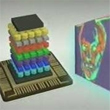Monday, 29 April 2013
A Microprocessor That Simulates a Synapse
 For decades now, cognitive scientists across the entire range from cognitivists to connectionists have been trying to use computers to model the learning abilities of the human brain. A team at MIT, headed by Dr. Chi-Sang Poon, has just taken a major step in this direction by designing a microprocessor that can simulate the functioning of a single synapse in the part of the human brain known as the hippocampus.
For decades now, cognitive scientists across the entire range from cognitivists to connectionists have been trying to use computers to model the learning abilities of the human brain. A team at MIT, headed by Dr. Chi-Sang Poon, has just taken a major step in this direction by designing a microprocessor that can simulate the functioning of a single synapse in the part of the human brain known as the hippocampus.
Learning and the memories that result from it depend on changing the efficiency of the synapses between the neurons in the brain’s circuits. There are two classic paradigms that attempt to explain this plasticity. According to one of these paradigms, the frequency of the nerve impulses that the presynaptic neuron sends across the synapse is what determines the amplitude and type of modification in the postsynaptic neuron, and hence the increase or decrease in the efficiency of the synapse. According to the other paradigm, it is instead the synchronization of the activity of the two neurons that is crucial.
At the molecular level, however, both paradigms assume a mechanism whereby the activation of calcium channels leads to the long-term potentiation or long-term depression of the synapse. Dr. Poon’s microprocessor, which is an analogue rather than a digital device, can simulate both of these paradigms explaining synaptic plasticity, thanks to its structure, which imitates the activity of the various ion channels in the synapse.
This new analogue microprocessor thus provides an unprecedentedly realistic picture of the behaviour of the ion channels that generate the nerve impulse, unlike earlier models based on digital simulations using equations calculated by computers.
Dr. Poon and his team have even successfully used a model generated with their microprocessor to support the hypothesis that long-term depression is produced by the binding of endocannabinoids (the human body’s endogenous equivalent of THC, the natural ingredient in cannabis) to presynaptic receptors!
![]() New computer chip models the brain by mimicking how neurons communicate
New computer chip models the brain by mimicking how neurons communicate
![]() A biophysically-based neuromorphic model of spike rate- and timing-dependent plasticity
A biophysically-based neuromorphic model of spike rate- and timing-dependent plasticity
Memory and the Brain | Comments Closed







